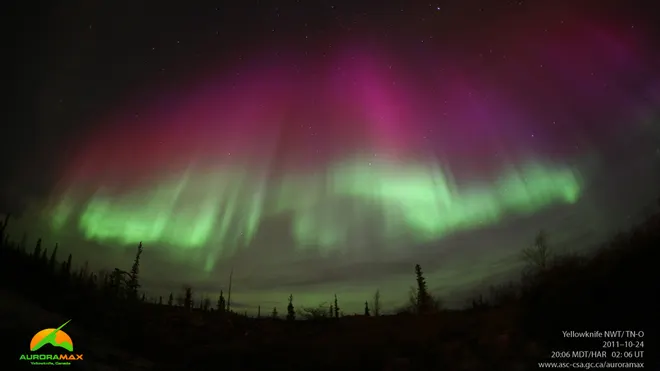
Aurora missed? What happened to the March 23 solar storm?
Multiple media sources hyped a solar storm and the potential for bright auroras this past weekend, but nothing materialized. So, what happened?
By many accounts, this past weekend was supposed to be an excellent opportunity for many across Canada and the northern United States to catch a glimpse of the Northern Lights. When the time came, though, skywatchers were left out in the cold - literally, in some cases - so what happened?
Back on March 20, a large 'filament' peeled away from the Sun, following a fairly weak C4-class solar flare from a sunspot known as AR2736.

Following the solar flare from the bright region, AR2736 (right of centre), watch the region of the sun just to the upper left of that, to see the dark filament lift away from the Sun's surface. Credit: NASA/SDO
This dark filament was composed of billions of tonnes of solar particles - electrons and protons - and as it was thrown out into space, it became what's known as a Coronal Mass Ejection.
Solar flares cause radio interference in Earth's upper atmosphere, immediately following the explosion of energy, however it's the CME that attracts the most attention.
This is because a CME that is directed more or less at Earth, brings with it the potential for bright auroras - sometimes even visible as far south as the United States.
Based on the speed forecasters witnessed as they watched this particular CME via the Solar and Heliospheric Observatory, and modelling its motion using computers, they estimated that it would arrive here in the afternoon (Eastern Time), on Saturday, March 23, 2019.
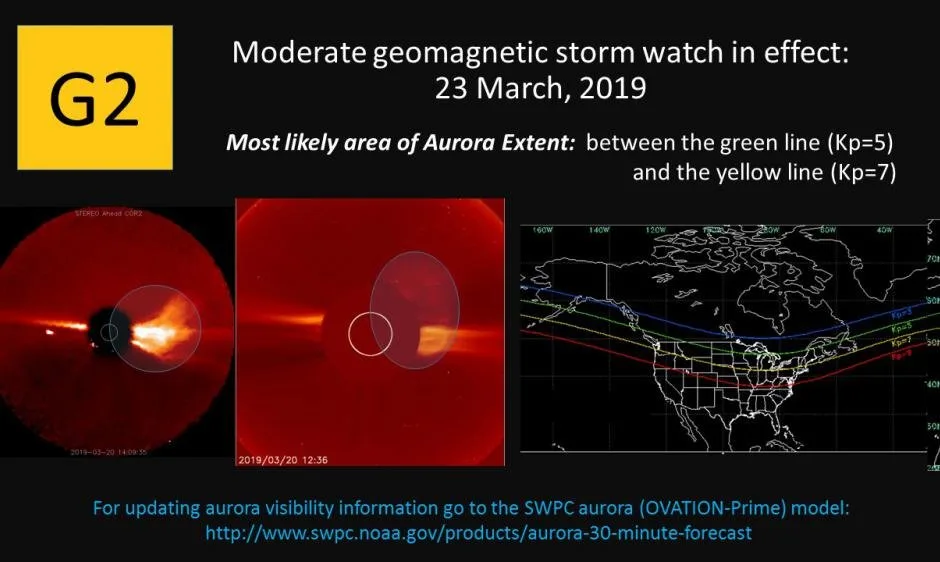
Space weather forecasters issued a G2 geomagnetic storm watch for March 23, 2019. Credit: NOAA SWPC
Excitement grew among skywatchers and aurora chasers, when space weather forecast models revealed the shape and evolution of the coronal mass ejection, as it left expanded out into space, and showed that it would likely be a direct hit on Earth!

This computer model shows the inner solar system, out to past Mars' orbit, from above (circular plot, left), from the side, following Earth in its orbit (wedge, centre), and behind Earth (rectangular view, right). The CME leaves the Sun on March 20, and reaches Earth (yellow dot), on March 23. The densest part of the plasma cloud, denoted in reds, is seen to impact Earth. Credit: NOAA SWPC
Such a hit on Earth's magnetic field usually ramps up the geomagnetic activity that results from an event like this, which typically produces more intense auroral displays.
As the weekend approached, word spread, online and through various media outlets, of the impending 'solar storm' or 'geomagnetic storm', and the auroras that it may spark in the sky.
The timing of the official forecast wasn't the greatest for Canada and the U.S., since the CME was predicted to arrive sometime Saturday afternoon, Eastern Time, which would tend to favour auroras over Siberia and northern Europe, rather than over North America.
Still, according to space weather forecaster Tamitha Skov, it's best not to get "hung up" on the arrival time in the forecasts.
"Remember, space weather forecasting is where terrestrial weather [forecasting] was in the 1960s," she said on Twitter. "The solar storm could arrive anytime on March 23. If it's fashionably late, it'll hit March 24!"
Saturday afternoon came and went. Saturday night passed, with no sign of the CME. In fact, geomagnetic activity was near zero, almost the entire weekend. Geomagnetic activity, which measures how active Earth's magnetic field is, is usually a very good indicator of how bright the auroras will be, and how far south they'll be visible.
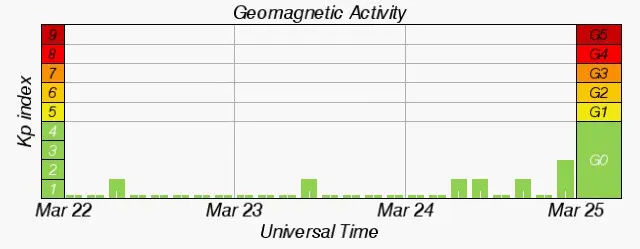
Geomagnetic activity, from March 22 to March 25, as measured against the 3-hour Planetary K-index (Kp). Any value above Kp=4 is considered to be 'geomagnetic storm' levels of activity. Credit: NOAA SWPC
It wasn't until late Sunday afternoon (EDT) that instruments on board the DSCOVR satellite, located at Lagrange Point 1 (L-1), 1.5 million km closer to the Sun than Earth, detected the arrival of the CME.
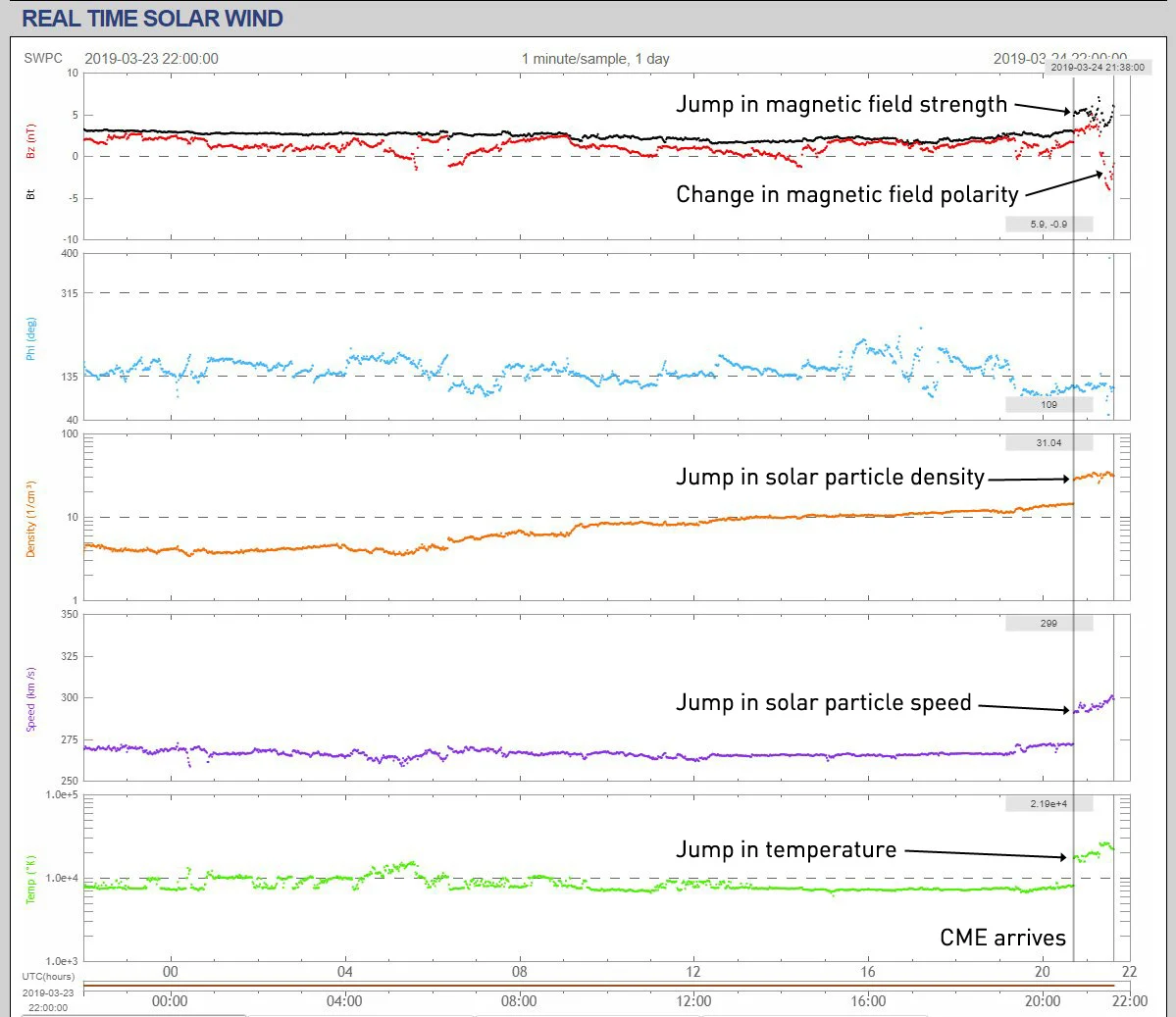
DSCOVR real-time solar wind measurements, of Magnetic Field (top plot, strength in black, direction in red), particle density (orange), particle speed (purple) and space environment temperature (green), all show a sudden change at 20:42 UTC on Sunday. Credit: NOAA
The sharp uptick in magnetic field strength, solar particle density, particle speed, and temperature, was a welcome sight for forecasters and space weather enthusiasts, alike.
At the same time, however, even after the solar storm arrived, apparently nothing happened.
As the 7-day view from DSCOVR shows, below, it was likely the slow speed of the CME that cost us the view of the auroras.
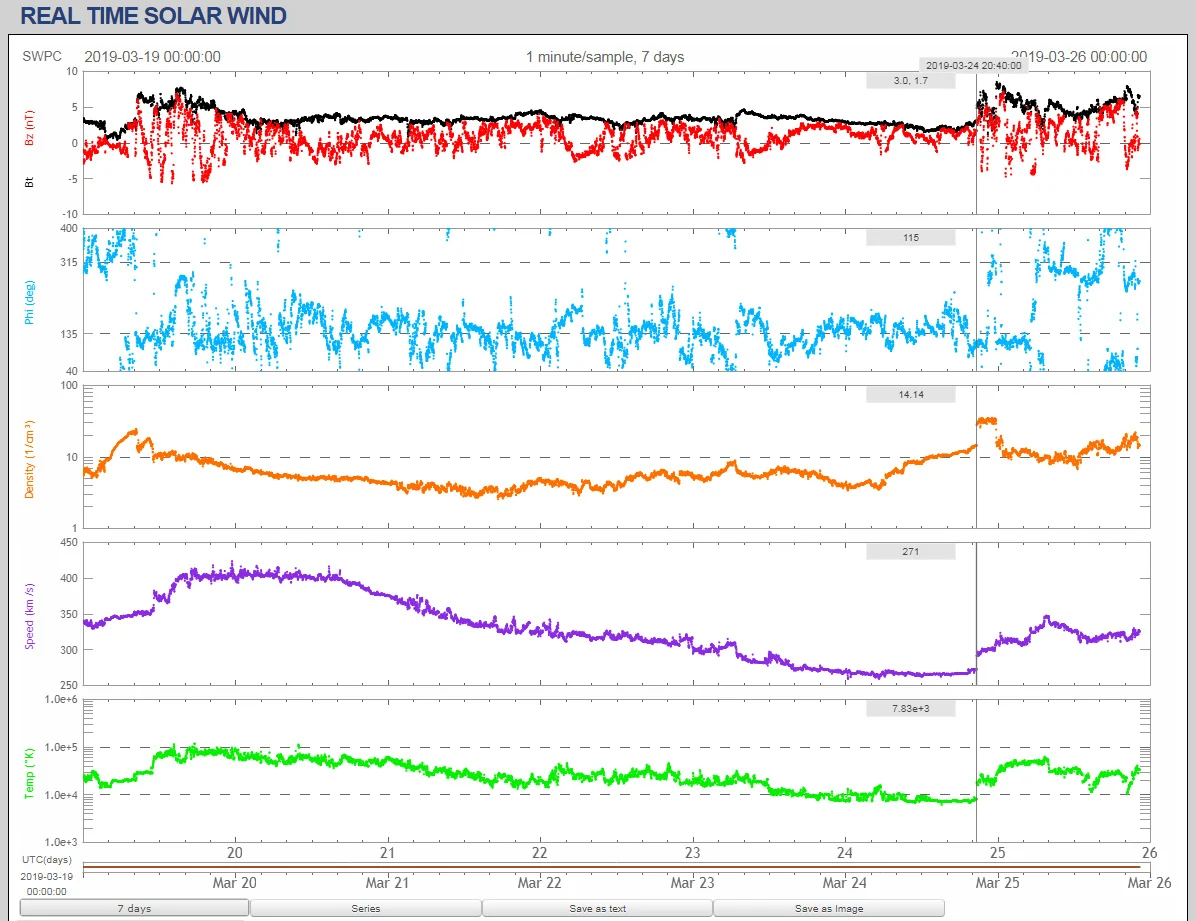
The 7-day data run from DSCOVR, from March 19-26 UTC, shows the impact of the March 19 solar wind, which did spark auroras across the north. In all areas, the March 24 CME produced similar impacts, except in speed. Credit: NOAA SWPC
Since temperature, density and speed are the three key properties that tend to have the biggest influence the impact of a CME on Earth's magnetic field, with temperature and density roughly similar, it was the lower speed of the March 20-24 CME - evident from its late arrival - that caused there to be little to no visible aurora.
So, why was the forecast off by more than a day?
SPACE (WEATHER) IS HARD
Modern-day weather forecasting is remarkable.
By using observations and reports from dozens of weather stations across the U.S. and Canada, along with computer modelling, a forecaster in Toronto can track an approaching Colorado Low weather system, over a distance of more than 2,000 km, and over the span of a few days, to give residents of Ontario a clear picture of the conditions (and potential risks) that storm will bring with it, and with exceptional timing as to when the storm will arrive.
In contrast, space weather forecasting is far more difficult.
Imagine trying to make the same 2-3 day weather forecast for Toronto, but only with a brief snapshot of how the Colorado Low was developing, while it was still over Colorado, and then nothing more after.
You can run your computer model, based on the information you gathered during that brief snapshot, and you have a general idea, based on your experience, of how long it takes for such a weather system to traverse the distance between Colorado and Ontario.
There are no more updates, however, until a weather station in Mississauga - on the western edge of the Greater Toronto Area - detects the falling pressure, changing winds and temperature, and precipitation associated with the weather system, as it arrives there.
This is the state of space weather forecasting these days.
NASA's Solar Dynamics Observatory can capture solar flares, and it can show us a coronal mass ejection just as it is leaving the Sun's surface. The NASA/ESA Solar and Heliospheric Observatory can take 'coronagraph' images that show us how that CME is moving through the space directly around the Sun, giving us an estimate of its initial density and speed.
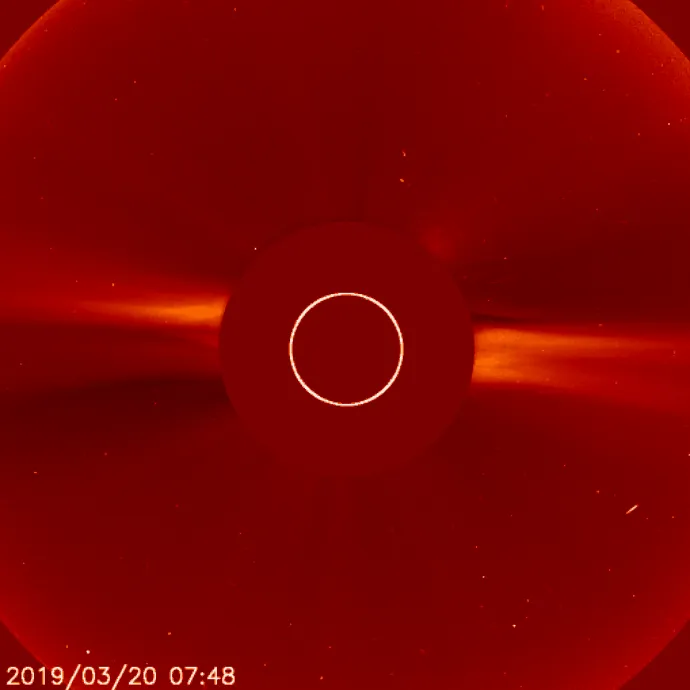
SOHO's coronagraph view of the solar corona for March 20, 2019. The CME emerges from behind the coronagraph shield at just after 12 UTC. Credit: NASA/ESA
After that, though, it's usually around 3 days before we get any more information about it, because that's how long it takes for the CME to reach the NASA/NOAA DSCOVER and NASA ACE satellites, located 1.5 million kilometres closer to the Sun than Earth.
Computer models that plot how a CME expands out into space do fairly well, most of the time. If the estimates fed into those models are off, however, even by a small amount, those errors propagate forward, meaning that, by the time the CME arrives here, the model result differs greatly from reality!
To compare to the weather forecast, again, it could mean that the most extreme part of the storm sweeps directly over Downtown Toronto, while the model has been indicating it would pass over Georgian Bay, instead.
Putting more money into space weather research can help. Developing new modelling techniques can benefit the field. Training more space weather forecasters would certainly put more minds to the task.
The real issue, however, is the lack of updated data on the coronal mass ejection.
WE NEED MORE SPACE (WEATHER STATIONS)
Terrestrial weather forecasters have dozens of weather stations to watch, as they monitor how a storm develops and moves over time, right up until the storm reaches them. They can then use all of that information to run new weather models, on a regular basis, to provide refinements to their forecast, and keep their viewers informed.
Watch below as a Colorado Low tracks across the US towards southern Ontario during the week of March 11, 2019
Space weather forecasters simply don't have anything comparable to that amount of data, because once a CME leaves the coronagraph view from SOHO, it effectively becomes invisible to us, here on Earth, until it reaches Lagrange Point 1. Only then can the satellites there give us an update on the CME's speed and strength.
Coronal mass ejections may look like dense blobs matter in the SDO and SOHO views, and in computer model runs, however the scale covered by those images is immense, and this tends to hide just how diffuse these particle clouds are. Particle densities measured by DSCOVER are around 10-100 particles per cubic centimetre. By comparison, one cubic centimetre of air contains around 10 quintillion molecules!
For space weather forecasters to have the same access to information, we would need to launch more satellites and spacecraft out into the inner solar system, and position them between the Sun and Earth, to give us constant updates on the solar wind, and the motion and properties of coronal mass ejections as they expand away from the Sun.
There are two biggest problems with implementing such a plan, however.
First, it is expensive, since it takes billions of dollars to design, build and launch a satellite. While those costs are coming down (and the invention of 'smallsats' and 'cubesats' also helps), it would still be very expensive to bring more 'space weather stations' online.
Second, it is extremely difficult to position a satellite properly so that it is closer to the Sun than Earth, yet it always stays between the Sun and Earth. We can do so at Lagrange Point 1 because it is a stable gravitational point in the Earth-Moon-Sun system, where you can set up a satellite in a 'halo orbit' around that point, and have it stay with the Earth as the planet travels around the Sun.
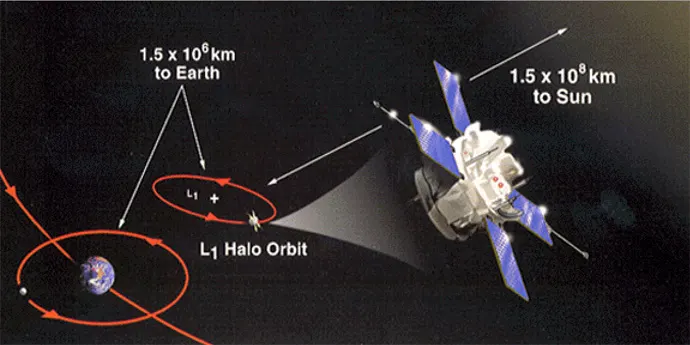
NASA's Advanced Composition Explorer (ACE) occupies a halo orbit around L-1, similar to the DSCOVR satellite. Credit: NASA
Move a satellite closer to the Sun from there, however, and it either has to pick up speed, thus pulling away from the Earth, or it will fall towards the Sun. Either way, it will move out of position to be useful as a space weather station.
The B612 Foundation, with their Sentinel Space Telescope, which is supposed to search for dangerous near-Earth asteroids, is proposed to use a solar sail, which would take advantage of light pressure to keep the spacecraft in position. That technology is still under development, though.
WHAT DO WE DO IN THE MEAN TIME?
Until such time as we can improve on space weather forecasting, by either getting more space weather stations into space, or finding new, innovative ways of tracking the solar wind and coronal mass ejections before they reach Earth, we need to accept where the field is, at this time.
This is not to say that we should dismiss space weather forecasts or forecasters. These scientists are making do with what they have available to them, and they do a very good job with the resources they have. It's just that there are inherent uncertainties that we are not going to be able to get around.
As Michael Cook, Space Weather Forecaster Lead at Apogee Engineering, said on Twitter, regarding this particular solar storm: "Arrival time was mid to late UTC-day [Sunday], with where we currently are in the Space Weather field (comparable to meteorology in the 1960s) always give +/- 24 hours for a forecast."
"If you can validate a forecast between 6-12 hours then that is a GREAT forecast!" he added, and indeed, many space weather forecasts are that accurate.
So, when it is announced that there is the potential for a solar storm and auroras, regardless of how far and wide it is being reported by the media, and how certain the timing seems, we - the readers and viewers - should always inject that uncertainty into what's being said, and plan accordingly.
Sources: Tamitha Skov | Michael Cook | NOAA SWPC











